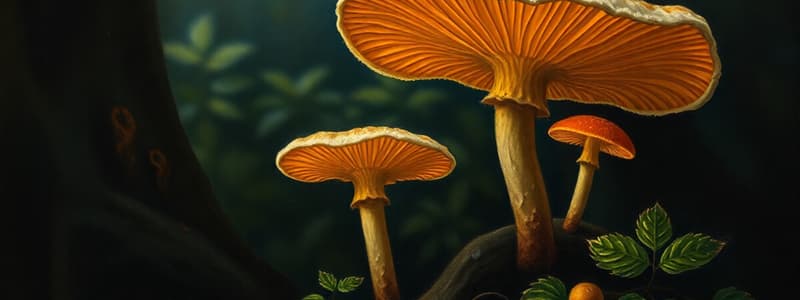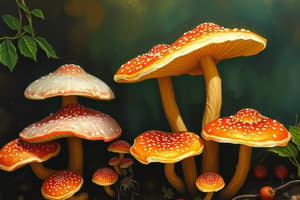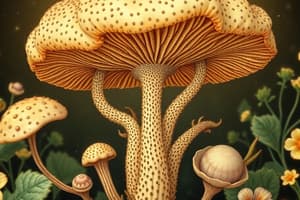Podcast
Questions and Answers
While plants and fungi may appear similar due to their immobile nature, a key distinction lies in their nutritional modes. Which of the following accurately describes the fundamental difference in how they obtain energy?
While plants and fungi may appear similar due to their immobile nature, a key distinction lies in their nutritional modes. Which of the following accurately describes the fundamental difference in how they obtain energy?
- Plants are heterotrophs, acquiring nutrients from decaying organic matter, while fungi are autotrophs, producing their own food through photosynthesis.
- Both plants and fungi are heterotrophs, relying on symbiotic relationships with other organisms to obtain the necessary nutrients for survival.
- Both plants and fungi are autotrophs, converting sunlight into energy, but fungi also supplement their nutrition by absorbing minerals from the soil.
- Fungi are heterotrophs, obtaining energy by decomposing organic material, while plants are autotrophs, producing their own food through photosynthesis. (correct)
The cell walls of both plants and fungi provide structural support, but they are composed of different materials. What are the primary components of cell walls in fungi and plants, respectively?
The cell walls of both plants and fungi provide structural support, but they are composed of different materials. What are the primary components of cell walls in fungi and plants, respectively?
- Cellulose in both fungi and plants.
- Chitin in both fungi and plants.
- Cellulose in fungi and chitin in plants.
- Chitin in fungi and cellulose in plants. (correct)
Fungi play a crucial role in terrestrial ecosystems as decomposers. How do fungi obtain nutrients from organic matter, contributing to nutrient cycling in the environment?
Fungi play a crucial role in terrestrial ecosystems as decomposers. How do fungi obtain nutrients from organic matter, contributing to nutrient cycling in the environment?
- By forming symbiotic relationships with plants to extract nutrients from their root systems.
- By engulfing organic matter through phagocytosis, similar to animal cells.
- By directly absorbing large organic molecules through their cell walls.
- By secreting digestive enzymes to break down organic matter externally and then absorbing the nutrients. (correct)
Plants and fungi, despite their differences, share a common evolutionary ancestor. According to the provided information, from which group of organisms did both plants and fungi likely evolve?
Plants and fungi, despite their differences, share a common evolutionary ancestor. According to the provided information, from which group of organisms did both plants and fungi likely evolve?
The hyphae of fungi and the root systems of plants can sometimes appear superficially similar to the untrained eye. However, a fundamental cellular feature differentiates fungi from plants. Which feature is present in plants but notably absent in fungi?
The hyphae of fungi and the root systems of plants can sometimes appear superficially similar to the untrained eye. However, a fundamental cellular feature differentiates fungi from plants. Which feature is present in plants but notably absent in fungi?
Flashcards
Fungi
Fungi
Organisms that decompose organic material and absorb nutrients. Reproduce via spores and have cell walls of chitin.
Plants
Plants
Organisms that are autotrophs, meaning they make their own energy through photosynthesis.
Fungi's Ecological Role
Fungi's Ecological Role
They break down organic matter and release nutrients back into the soil.
Chitin
Chitin
Signup and view all the flashcards
Detritus
Detritus
Signup and view all the flashcards
Study Notes
- Fungi, often mistaken as similar to plants, are distinct organisms.
- Fungi are decomposers, breaking down organic material and absorbing nutrients.
- Fungi reproduce by releasing spores.
- Fungi are heterotrophs, obtaining energy from organic substances.
- They secrete digestive enzymes to break down organic material and absorb nutrients.
- Fungi cell walls are made of chitin for structural support.
- Chitin is a polysaccharide found in insect exoskeletons and other invertebrates.
- Truffles, molds, yeasts, mushrooms, and mildews are examples of fungi.
- Plants are autotrophs, producing their own energy through photosynthesis.
- Plants are producers, using radiant energy to create food.
- Chlorophyll in chloroplasts converts carbon dioxide and water into glucose using sunlight.
- Plants reproduce through seeds or spores.
- Plant cell walls are made of cellulose, providing structural support.
- Grass, trees, flowers, and ferns are examples of plants.
- Plants and fungi evolved from protists, single-celled eukaryotic organisms.
- Eukaryotic organisms have cells with membrane-bound organelles and DNA in a nucleus.
- Both plants and fungi are immobile, and fungal hyphae resemble plant roots.
- Fungi lack chloroplasts and have chitin cell walls, unlike plants.
Evolution of Fungi
- The fungi kingdom has significant biological diversity, with approximately 3.8 million species, but only 100,000 identified.
- Fungi are essential decomposers, breaking down organic matter and releasing nutrients into the soil.
- Earliest fungi species were likely aquatic, with symbiotic relationships with photosynthetic bacteria.
- Approximately 460 million years ago, fungi adapted to land, becoming some of the first terrestrial organisms.
- Fungi aided plant evolution by releasing nutrients into the soil by breaking down detritus.
- Detritus is waste matter from rocks, minerals, and organic material.
- During the Devonian Era (419.2 to 358.9 million years ago), Prototaxites, gigantic fungi as tall as 26 feet, existed.
- The K-T extinction event (65 million years ago) favored fungi growth due to plant decay.
- Mammals survived the K-T extinction because they were too hot for fungal pathogens that affected reptiles.
- Fungi are adaptable and can survive in hazardous conditions.
- Most fungi are terrestrial decomposers, thriving on dead organic matter.
- Parasitic fungi can cause diseases, such as ringworm on humans.
- Fungi are found in Antarctica, cockroaches, and nuclear power plants.
When Did Fungi First Appear?
- Fungi first appeared about one billion years ago, diverging from animals.
- Microscopic organisms with chitin-containing filaments were discovered in Arctic Canada.
- This suggests fungi are older than the previously thought 600 million years.
- However, some researchers are skeptical about the ancient fungi findings in Arctic Canada.
Phylogeny of Fungi
- The phylogeny of fungi explains common ancestry and evolutionary development.
- There are five phyla of fungi and one informal group called Deuteromycota:
- Chytridiomycota (the Chytrids):
- Appeared about 500 million years ago and are a group of simple true fungi.
- Mostly unicellular and reproduce sexually and asexually.
- Live in aquatic environments, some parasitically on land.
- Zygomycota (the conjugated fungi):
- Saprobes that thrive on decaying organic matter.
- Some are parasitic on insects and found on bread, fruit, and vegetables.
- Ascomycota (the sac fungi):
- Have sac-like structures that disperse ascospores.
- Yeasts are commonly used in baking and brewing.
- Some species are parasitic on plants and animals.
- Basidiomycota:
- Characterized by a fruiting body and gill-like structures under the cap.
- A network of mycelium grows underground.
- Reproduce through alternation of generations, with both sexual and asexual spore production.
- Glomeromycota:
- Live in mutualistic symbiotic relationships with plant life.
- Require plant roots to survive.
- DNA suggests they descended from a common ancestor (monophyletic lineage).
- Deuteromycota (the imperfect fungi):
- Reproduce asexually.
- Considered a polyphyletic group with multiple ancestral relationships.
- Very diverse and known as mold.
- Mold grows in hyphae, which are multicellular structures.
- Chytridiomycota (the Chytrids):
Mushroom Evolution
- Mushrooms are fungi with fruiting bodies and underground mycelium.
- Mycelium is a network of hyphae that absorbs and transports nutrients.
- Mushrooms reproduce by releasing spores.
- Mushrooms are part of the Basidiomycota phylum.
- The earliest mushrooms evolved approximately 815 to 715 million years ago.
- They possibly played a key role in plant evolution on land.
- Mycelium remains have been found in rocks dated between 810 to 715 million years old.
- Mushroom fossils are rare due to their delicate structure, resulting in gaps in the fossil record.
- The earliest mushroom fossils are approximately 460 million years old.
- Fruiting body development was an evolutionary step in sexual reproduction in fungi.
- Gill-like structures under the cap of mushrooms increased the surface area for spore production.
- Some mushroom species developed toxicity as a defense mechanism.
Evolution of Plants
- Photosynthetic eukaryotic protists resembling algae were early plant species that evolved from cyanobacteria.
- Fossils of these organisms are dated to be about 1700 million years old.
- Early plant life was aquatic until 510 to 439 million years ago.
- Bryophytes, including mosses and liverworts, were some of the earliest nonvascular land plants.
- Nonvascular plants lack specialized structures for transportation.
- Lacking a vascular system, nonvascular plants grow on the ground surface and are smaller than vascular plants.
- Vascular plants evolved approximately 425 million years ago.
- Vascular plants have xylem and phloem for water and food transport.
- Vascular plants grow larger than nonvascular plants and include trees, angiosperms, and gymnosperms.
- Nonvascular plants reproduce through the alternation of generations.
- The sporophyte generation produces spores for asexual reproduction.
- The gametophyte generation produces sperm and eggs.
- Gymnosperms (naked-seed plants) evolved 305 million years ago and reproduce through seeds.
- Male and female reproductive organs are cones without flowers or fruits.
- Gymnosperms mostly reproduce through wind dispersal.
- Angiosperms (flowering plants) evolved 140 million years ago and reproduce through seeds in fruit.
- Angiosperms contain flowers that house reproductive organs and aid in pollination.
- Angiosperms are the most evolutionarily advanced plants, with flowers and fruit for seed dispersal.
When Did Plants First Appear?
- The earliest evolutionary relationship with plants is with prokaryotes.
- Prokaryotes are unicellular organisms without membrane-bound organelles and DNA not in a nucleus.
- Prokaryote evidence was discovered in stromatolites dated 2700 million years ago.
- Cyanobacteria, blue-green algae, formed ancient stromatolites and contributed to atmospheric oxygen.
- Cyanobacteria contained photosynthetic pigments like chloroplasts in algae and plants, suggesting an evolutionary relationship.
Classification of Plants
- Plants are classified by spore or seed reproduction, the presence of a vascular system, flowers, and the number of seed leaves.
- Spore-reproducing plants: include ferns, mosses, liverworts, and algae.
- Seed-bearing plants: include angiosperms and gymnosperms.
- Vascular plants: have vascular tissues for transport and include trees, angiosperms, and gymnosperms.
- Non-vascular plants: include mosses and liverworts.
- Angiosperms: house seeds in fruit and produce flowers.
- Gymnosperms: have naked seeds not contained within a fruit and reproduce through cones (conifers).
- Angiosperms: categorized into monocots (one seed leaf, petals divisible by three) and dicots (two seed leaves, four, five, or more petals).
Similarities in Fungi and Plant Evolution
- Fungi and plants are eukaryotic organisms that evolved from single-celled organisms.
- They both evolved from early protists, share a cell structure, and have similar root structures and growth patterns.
- Plants and fungi have symbiotic relationships with other organisms, both beneficial and parasitic.
- Fungi and animals are heterotrophs, gaining nutrition from other sources.
- DNA evidence suggests a close ancestral relationship between fungi and humans, branching away from plants about 1.1 billion years ago.
- Animals and plants later branched off from each other, sharing ancestry with a single-celled organism with flagella.
Studying That Suits You
Use AI to generate personalized quizzes and flashcards to suit your learning preferences.




